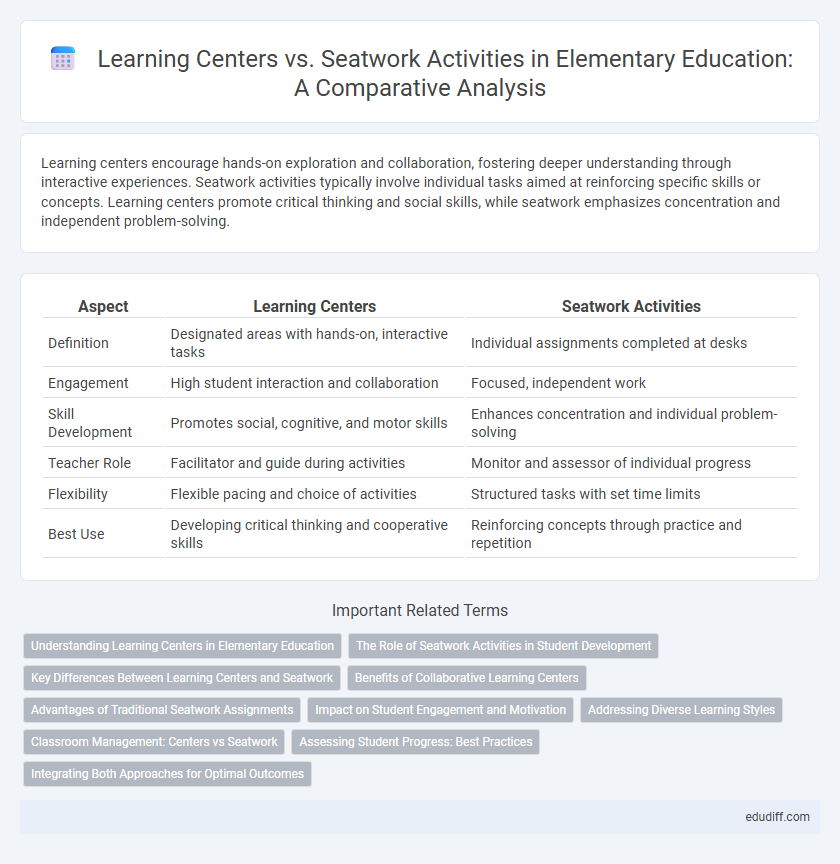Learning centers encourage hands-on exploration and collaboration, fostering deeper understanding through interactive experiences. Seatwork activities typically involve individual tasks aimed at reinforcing specific skills or concepts. Learning centers promote critical thinking and social skills, while seatwork emphasizes concentration and independent problem-solving.
Table of Comparison
| Aspect | Learning Centers | Seatwork Activities |
|---|---|---|
| Definition | Designated areas with hands-on, interactive tasks | Individual assignments completed at desks |
| Engagement | High student interaction and collaboration | Focused, independent work |
| Skill Development | Promotes social, cognitive, and motor skills | Enhances concentration and individual problem-solving |
| Teacher Role | Facilitator and guide during activities | Monitor and assessor of individual progress |
| Flexibility | Flexible pacing and choice of activities | Structured tasks with set time limits |
| Best Use | Developing critical thinking and cooperative skills | Reinforcing concepts through practice and repetition |
Understanding Learning Centers in Elementary Education
Learning centers in elementary education provide interactive, hands-on activities that promote student engagement and collaboration, fostering critical thinking and problem-solving skills. Unlike seatwork activities, which often involve individual, repetitive tasks, learning centers encourage exploration through diverse materials and peer interaction. This approach supports differentiated instruction by addressing various learning styles and allowing students to progress at their own pace.
The Role of Seatwork Activities in Student Development
Seatwork activities play a crucial role in student development by fostering independent learning and reinforcing concepts taught during lessons. These tasks encourage students to practice critical thinking, problem-solving, and time management skills within a structured environment. Seatwork also provides immediate feedback opportunities, helping teachers assess individual progress and identify areas needing improvement.
Key Differences Between Learning Centers and Seatwork
Learning centers provide hands-on, interactive experiences that encourage collaboration and exploration, while seatwork activities focus on individual, task-based practice often involving worksheets. Learning centers are designed to foster critical thinking and problem-solving skills through varied materials and group interaction, whereas seatwork emphasizes repetition and skill reinforcement at the student's own pace. The key difference lies in the active learning environment of centers compared to the more passive, structured nature of seatwork.
Benefits of Collaborative Learning Centers
Learning centers in elementary classrooms promote social interaction, critical thinking, and hands-on engagement, enriching students' understanding compared to individual seatwork activities. Collaborative learning centers foster teamwork skills and allow peer-to-peer support, leading to improved communication and problem-solving abilities. Research shows students in cooperative settings demonstrate higher retention and motivation than those working alone.
Advantages of Traditional Seatwork Assignments
Traditional seatwork assignments promote independent learning by allowing students to practice skills at their own pace, reinforcing concepts learned in class. These tasks improve concentration and responsibility, as students must manage time and complete assignments individually. Seatwork also provides teachers with clear, measurable outcomes to assess student understanding efficiently.
Impact on Student Engagement and Motivation
Learning centers provide hands-on, interactive experiences that significantly boost student engagement by catering to diverse learning styles and promoting collaboration. Seatwork activities often emphasize individual task completion, which can limit motivation for students who thrive on social interaction and dynamic challenges. Incorporating learning centers into elementary classrooms fosters a more stimulating environment that enhances motivation and active participation.
Addressing Diverse Learning Styles
Learning centers offer hands-on, interactive experiences tailored to kinesthetic, visual, and auditory learners, promoting engagement through varied materials and group collaboration. Seatwork activities primarily support independent practice, often benefiting students who excel with structure and repetition but may not fully address all learning preferences. Integrating both methods creates a balanced classroom environment that meets diverse learning styles, enhancing overall student understanding and retention.
Classroom Management: Centers vs Seatwork
Learning centers promote active engagement by allowing students to explore tasks independently or in small groups, reducing teacher-led instruction time and enhancing classroom management through clear routines and student accountability. Seatwork activities involve individual tasks completed at desks, requiring consistent supervision to maintain focus and minimize disruptions in the classroom setting. Effective classroom management balances the use of centers for collaborative learning with seatwork to reinforce skills, optimizing student behavior and instructional time.
Assessing Student Progress: Best Practices
Learning centers provide hands-on, interactive experiences that allow teachers to observe and assess student understanding in real-time, making it easier to identify strengths and areas for improvement. Seatwork activities offer structured tasks that help measure individual student progress through completed assignments and quizzes, providing concrete data for evaluation. Combining both methods ensures a comprehensive assessment strategy that supports personalized learning and continuous progress tracking in elementary education.
Integrating Both Approaches for Optimal Outcomes
Integrating learning centers and seatwork activities enhances elementary education by combining hands-on, interactive exploration with focused individual practice. Learning centers foster collaboration, creativity, and critical thinking through thematic, engaging tasks, while seatwork activities reinforce core skills via structured, independent exercises. Balancing these approaches maximizes student engagement, accommodates diverse learning styles, and promotes comprehensive understanding.
Learning Centers vs Seatwork Activities Infographic

 edudiff.com
edudiff.com